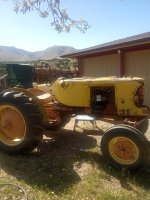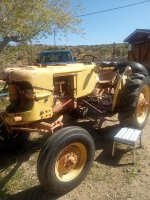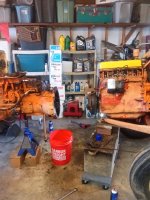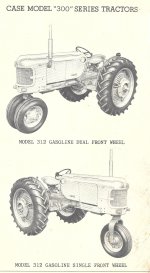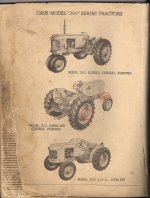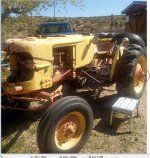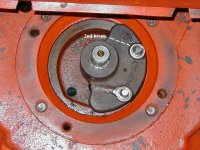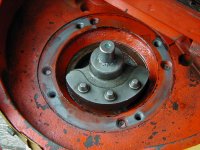You should upgrade or use an alternative browser.
- Thread starter chris142
- Start date
J Hamilton
Well-known Member
- Location
- Southern Illinois
J Hamilton
Well-known Member
- Location
- Southern Illinois
If you could post a couple pictures of your tractor, we can most likely identify it for youI dont know what row crop ,high crop etc is. Its gas powered so that leaves 310,311,312 or 320. Whats the difference gerween an industrial and a utility?
J Hamilton
Well-known Member
- Location
- Southern Illinois
Thank you! any idea if its a 56 or 57? any way to know? engine serial?It looks to me like a model 311. Gasoline engine, and adjustable front and rear tire width. The adjustable width makes the tractor wide or narrow for cultivating different crops, making it a (row crop) tractor
You have a model 311 general purpose tractor. Adjustable front and rear tread.All I got right now
I have a 1956 model 310 utility tractor. Solid front and rear axle. The rear axle is adjustable by disk position. 300 series tractors can be diesel, gas or propane.
Attachments
Thank you! No way to know the actual year? I don't know why I want to know that.You have a model 311 general purpose tractor. Adjustable front and rear tread.
I have a 1956 model 310 utility tractor. Solid front and rear axle. The rear axle is adjustable by disk position. 300 series tractors can be diesel, gas or propane.
Tgrasher
Well-known Member
- Location
- South Southern illinois
Just a heads up on taking care of your 300: oil your distributor on the outside oiler and in the top of the shaft, distributors are hard to find and rebuilt ones prices are crazy. If you have not put any gear oil in the front steering gear box, check it, add a little and see if it holds or leaks it. If it leaks put light weight grease in it if your OK with the amount of play in the steering. Keep your engine oil changed as the main bearings for the 1956-57 G148 are not available. Your gage cluster has oilers for the speedometer and tachometer. Usually they are never oiled nor the cables which causes the cables to seize up and break. New cables were $17 a few years ago but make sure the inside of the gage cluster is free of debris or damage to the fine springs of both can happen.
Attachments
Tgrasher
Well-known Member
- Location
- South Southern illinois
My steering box leaks so I put JD cornhead grease in it after gear oil leaked out. A great improvement in ease of stearing compared to gear oil.By the style of the outside of your fenders, I would say you have a 1957. Early 300's had a box type of reinforcement to strengthen them. Later models had the vertical angled steel like your fenders have.
Just a heads up on taking care of your 300: oil your distributor on the outside oiler and in the top of the shaft, distributors are hard to find and rebuilt ones prices are crazy. If you have not put any gear oil in the front steering gear box, check it, add a little and see if it holds or leaks it. If it leaks put light weight grease in it if your OK with the amount of play in the steering. Keep your engine oil changed as the main bearings for the 1956-57 G148 are not available. Your gage cluster has oilers for the speedometer and tachometer. Usually they are never oiled nor the cables which causes the cables to seize up and break. New cables were $17 a few years ago but make sure the inside of the gage cluster is free of debris or damage to the fine springs of both can happen.
The problem with a 2 stud lever is the crescent shape of the lever, the leading stud lash opens while making a turn so the trailing stud assumes nearly all the load. The 3 stud lever has two trailing studs to assume the load.
Thanks. It does not have an outside oiler on the distributer. It does have a metal plug that looks factory where one would have been. Are you saying to remove the rotor and put oil there? I'm pretty good about engine oil and I know that it just has a bypass oil filter. It had a pretty rough life before I got it. Had not had an oil change in decades judging by the sludge I saw when I had the valve cover off. I acted like I didnt see that.By the style of the outside of your fenders, I would say you have a 1957. Early 300's had a box type of reinforcement to strengthen them. Later models had the vertical angled steel like your fenders have.
Just a heads up on taking care of your 300: oil your distributor on the outside oiler and in the top of the shaft, distributors are hard to find and rebuilt ones prices are crazy. If you have not put any gear oil in the front steering gear box, check it, add a little and see if it holds or leaks it. If it leaks put light weight grease in it if your OK with the amount of play in the steering. Keep your engine oil changed as the main bearings for the 1956-57 G148 are not available. Your gage cluster has oilers for the speedometer and tachometer. Usually they are never oiled nor the cables which causes the cables to seize up and break. New cables were $17 a few years ago but make sure the inside of the gage cluster is free of debris or damage to the fine springs of both can happen.
It has pretty severe piston slap on #1 that gets quieter as it warms up. I assume its broken. Still has enough compression to run with any 3 plug wires removed though.
It's quietest on 20w50.
None of the dash works except for the Ammeter and oil pressure. All the cables are gone and someone swapped it over to 12v with an alternator and regulator from a 60's GM car or truck. Has a block ballast resister installed to protect the points.
I seem to remember putting oil in the steering box and it just ran out years ago.
pulled off the rotor and put some there. Will check if it went down any tonight,
I found another thread on carbureators that said the carb was dated. I found mine and its 6-57. Assuming its original that would coincide with my tractor being a 57.
Tgrasher
Well-known Member
- Location
- South Southern illinois
This is an Auto-lite distributor from a 300 like I was referring to. They also came with a Prestolite which I believe had a similar oiler. Your's must have been broken and replaced with the plug. Since you will have the cap off to oil the shaft in the top, remove the plug and squirt some in the hole while working the shaft back and forth. The shaft has bronze bushings it turns on. The top part of the shaft turns with the timing advance inside the lower part and this is what wears along with the bronze bushings. The result is erratic running of the motor as the spark and timing change on their own. You might consider putting a bottle of STP in the oil, it sounds like you need all the help you can with your bearings. The cut cables are par for the course on abused tractors, as long as you have oil and amp gages working your good, the heat would only be of concern if you were working it hard, and then you will see excess blow by coming from the breather on the valve cover.Thanks. It does not have an outside oiler on the distributer. It does have a metal plug that looks factory where one would have been.
Tgrasher
Well-known Member
- Location
- South Southern illinois
thing has zero blowby. I actully put in a mechanical temperature guage years ago. Put a new 180 thermostat in it last week while i had it split. been using cardboard as a thermostat foreverThis is an Auto-lite distributor from a 300 like I was referring to. They also came with a Prestolite which I believe had a similar oiler. Your's must have been broken and replaced with the plug. Since you will have the cap off to oil the shaft in the top, remove the plug and squirt some in the hole while working the shaft back and forth. The shaft has bronze bushings it turns on. The top part of the shaft turns with the timing advance inside the lower part and this is what wears along with the bronze bushings. The result is erratic running of the motor as the spark and timing change on their own. You might consider putting a bottle of STP in the oil, it sounds like you need all the help you can with your bearings. The cut cables are par for the course on abused tractors, as long as you have oil and amp gages working your good, the heat would only be of concern if you were working it hard, and then you will see excess blow by coming from the breather on the valve cover.
Similar threads
- Replies
- 5
- Views
- 5K
- Replies
- 6
- Views
- 434
- Replies
- 13
- Views
- 944
We sell tractor parts! We have the parts you need to repair your tractor - the right parts. Our low prices and years of research make us your best choice when you need parts. Shop Online Today.
Copyright © 1997-2024 Yesterday's Tractor Co.
All Rights Reserved. Reproduction of any part of this website, including design and content, without written permission is strictly prohibited. Trade Marks and Trade Names contained and used in this Website are those of others, and are used in this Website in a descriptive sense to refer to the products of others. Use of this Web site constitutes acceptance of our User Agreement and Privacy Policy TRADEMARK DISCLAIMER: Tradenames and Trademarks referred to within Yesterday's Tractor Co. products and within the Yesterday's Tractor Co. websites are the property of their respective trademark holders. None of these trademark holders are affiliated with Yesterday's Tractor Co., our products, or our website nor are we sponsored by them. John Deere and its logos are the registered trademarks of the John Deere Corporation. Agco, Agco Allis, White, Massey Ferguson and their logos are the registered trademarks of AGCO Corporation. Case, Case-IH, Farmall, International Harvester, New Holland and their logos are registered trademarks of CNH Global N.V.
Yesterday's Tractors - Antique Tractor Headquarters
Website Accessibility Policy


